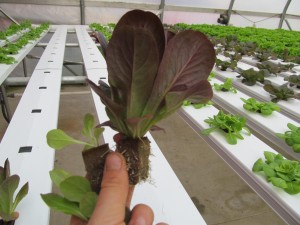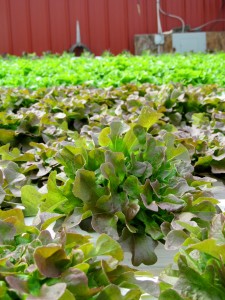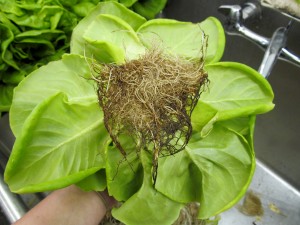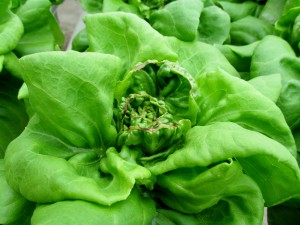Although hydroponic lettuce production has its benefits, it is not a care free system. Even if the nutritional and environmental demands of a plant are met, problems will occur without fail. It can be noted that most, if not all, of these issues are preventable with the proper care and management. Here are some of the issues I dealt with throughout my internship:
Responses to Overcrowding (Shade Avoidance)

Right plant shading out adjacent plant. The left plant will not have enough time to catch up developmentally and isn’t worth planting, hence, a loss in profit both for the cost of the wasted seed and the loss of a finished lettuce plant.
Plants are sensitive life forms. They have evolved to elicit responses due to the slightest change in environment. Plants are always reaching for the perfect amount of sunlight. Too little sunlight equates to less energy capture and over a prolonged time, death or delayed life cycles. When the lettuce seeds are planted in a foam tray, it’s a race for the seedlings to germinate and capture light. As the plants begin growing, they send out leaves to capture the sunlight. As the plant enlarges, it becomes aware of surrounding plants due to the difference in light quality (far red to red ratios). The plants will sense other plants are shading them out (a larger far red quantity) and therefore bolt up. Over time, they will begin shading out other plants.
Had the lettuce plugs been planted earlier on before this response was so extreme (possibly two weeks earlier), both plants would develop into gorgeous, phenomenal looking bundles of lettuce. It could be noted that although the second plant isn’t used, it may still be able to be planted into another batch of lettuce with proper planning and management.
“Twinning”
Lettuce seeds are quite small, even when covered with different fungicides, chemicals or packaged with nutrients. Be it human error or carelessness, two seeds can be placed, unintentionally, in one foam plug. Both seeds will germinate and immediately begin competing for light, nutrients and water. Many times, one plant will survive, yet, that is not always the case. If the person planting the lettuce does not notice two plants in one plug during planting (or any time before extreme physical changes occur due to the second plant), a “twinning” effect will take place.

Twinning red oakleaf lettuce plants. From this view (looking at one plant), it’s easy to see the dramatic height difference between that and the single plants per plug.
Although it may seem ideal to grow two plants in one plug as a customer, it creates havoc as a grower. This plug will break uniformity in the crop. Although many customers may see this as a plus (two plants for the price of one!), it also may create an unappetizing look for the rest of the crop. Thirdly, these two plants will shade out other plants as the day progresses. Fourthly and finally, this plug will need twice the nutrients and water to grow, which means a slightly elevated cost.
Tip Burn
Greenhouse growing allows more control over environmental conditions. For example, torrential rain was a huge problem during my internship this summer. With silty fields, one heavy rain could equal a loss of thousands of dollars, time and wasted labor. This isn’t a problem in a greenhouse, of course. Yet, a grower can’t have everything: tip burn occurs. The plant will get too much light and oxidize, hence the brown colored burn. Although the burned areas can be pinched off, the uniformity of the crop will be lost.
To prevent this problem, a partial shade can be used to reduce the sunlight. Or, more light tolerable varieties could be utilized.
Root Burn

Root burn on Green Bibb lettuce. Notice the black roots around the edge, the brown roots and the beige roots located close to the center of the plant.
A nice way to determine the last possible moment to harvest a crop completely is to look for root burn. Healthy hydroponic roots will be a white, ivory color. The roots of dying plants (or stressed plants) will be a beige, brown or black color. If there is a deficit of water, which would indicate that the plant is too large to be maintained by the current amount of nutrients and water, the roots will begin to brown before the plant’s leaves show any signs of damage. So, by pulling up a few random plants (one closer to the tube, one in the middle of the channel, one closer to the end of the channel), it can be determined when to pull the rest of the plants.
When we processed lettuce, we would snip off the main portion of roots and leave a roughly 1/2 inch of roots still on the plug. Consumers would not see the root burn and would buy the plants. Had we left the root burn on, it is possible that the consumer would not purchase the plant because it did not look “perfect,” although they do not consume the roots anyways. The 1/2 inch of roots allow the plant to take up water. Given the delicate nature of lettuce, an hour of heat can create a wilting plant.



Inadequate root development of hydroponic lettuce seeds in Oasis cubes. Is it the excessive sunlight, elevated temperatures, a varietal issue, etc? What are your views on this?
Truly, inadequate root development could be the effects of all the environment, not just one component. It could be the roots are not wet enough or too wet. If the roots aren’t wet enough it may be because of excessive sunlight and elevated temperatures (think evaporation) and it could also be that the irrigation hasn’t been perfected enough. For example, we had to monitor channels frequently on very hot and cloudy/sunny changing days because the timers with the irrigation may not have been set at ideal lengths given the rate of evaporation.If the cubes are too wet, usually you can see green algae on them. Remember, algae would be competing against the lettuce. If your seeds are not germinating and have no signs of germinating (look for dried up leaves or stems, dissect the seed to see any development), I would assume the seed itself caused inadequate root germination. If you’ve been using the same seed for a fairly long time, have not ever had a problem with it, and are keeping them in an ideal or relatively stress free environment, maybe you got a “bad” batch of seeds or your seeds were kept in a way that inhibited growth. Another good point is that if the leaves aren’t capturing sunlight, energy isn’t being produced. If energy isn’t produced, the roots won’t be able to further their growth. Finally, have the nutrient requirements been met? Plants are like humans: feed them right and they are the poster child of health, feed them poorly and development (or growth) will be halted.
We are starting our lettuces in rockwool inside the headhouse at our farm for transplant into a NFT system. We have a 40% shade cloth over our channels.
We moved our seedlings inside for germination due to the heat here in Mississippi. Upon germination we move them into the nursery in the greenhouse. They have started to bolt out of the cubes and are long stemmed before they are ready for transplant.
Is this heat, humidity or both? Any advice on how to prevent this or better handle our seedlings once this happens?